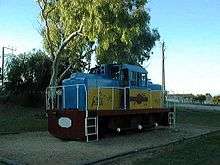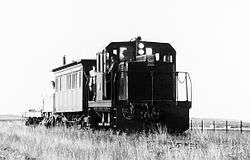Commonwealth Railways NC class
|
NC1 on a work train near Orroroo in 1996 | |||||||||||||||
| |||||||||||||||
| |||||||||||||||
| |||||||||||||||
The NC class were a class of diesel-hydraulic locomotives built by Clyde Engineering, Granville for the Lakewood Firewood Company, Kalgoorlie in 1956 and later sold to the Commonwealth Railways.
Description
Clyde Engineering advertised the DH series as a light purpose shunt and mainline locomotive, mainly for light railways and sugar cane service. The design allowed for multiple unit operation, the installation of dynamic brakes and a combination of air and vacuum braking systems.[1] Similar, though smaller versions were being built by Clyde. These were the DH1-71 series and totaled 33.[2]
A single General Motors 6/110 two stroke diesel engine provided power through an Allison CRT5630 hydraulic transmission to mechanically coupled wheels. Cabs consisted of two control consoles, both facing the same direction. Maximum design speed was 60 km/h.
History
The Lakewood Firewood Company (LFC) provided timber to the various mines in the "Golden Mile" region of Kalgoorlie, Western Australia. Its operations extended to the south and east of Kalgoorlie. This area covered from Kalgoorlie to Lake Lefroy and the Eyre Highway.[3]
At the time of ordering, the LFC were using an aging fleet of small steam locomotives. But by the time the locomotives were delivered, the company were in the middle of a rapid decline for demand for wood as mines closed or switched power sources.
By the time they were delivered, traffic on the LFC network had fallen from two trains a day, to two trains a week. Their introduction led to the end of steam operations on the railway, although they were unpopular with crews "only because they were die-hard steam men".[3] By 1962, the company employed less than 50 people, a far cry from the 550 employed at its peak. The last train ran on December 1964, to clean up the system. All of its rollingstock, except the two diesels, were scrapped.
Commonwealth Railways purchased the two locomotives in 1965. LFC1 was renumbered NC1 and spent time in Port Augusta workshops where the braking systems were modified for the Westinghouse air brake systems, the modified air intake system was removed. In November 1966 it was shipped north to Darwin, where it was employed as yard shunter on the North Australia Railway. It returned south in 1972.[4]
NC2 was used as yard shunter in Port Augusta until 1970, until NB30, returned from duties on the Hawker line. Subsequently, NC1 replaced NB30 as yard shunter in 1972, with NC2 being used as a source of spare parts.
In July 1975 both were included in the transfer of the Commonwealth Railways to Australian National.
By 1982, NC1 had become more or less obsolete. The need to maintain a narrow gauge yard shunter at Port Augusta had diminished with the closure of the Central Australia Railway in 1980. In July 1982, NC2 was sold to the Pichi Richi Railway,[5] and in 1985, NC1 was transferred to the now defunct Steamtown.[6]
Preservation
NC1
NC1 remained in Port Augusta until 1985. Australian National approached Steamtown to gauge availability of a number of tanker wagons that had been collected in Peterborough. At the time, Australian National was handling increasing quantities of Mereenie Crude oil. A deal was struck that saw Steamtown exchange its tanker wagons for NC1 with the locomotive arriving in Peterborough on 15 April 1985.[7]
NC1 went on to be the pivotal engine for the organisation. It hauled a number of passenger trains when steam was not available, was often seen running work trains on the line, and when not hauling passenger trains, provided back up power and braking capacity.
Whilst assisting with the recovery of W901, which had derailed in Eurelia Yard in early 1988, the "rear drive assembly" seized, and required major work. This was reported as being completed by mid-1991.[8][9]
Steamtown initially painted the locomotive in the "Invisible Green" scheme associated with the Peterborough Division, but in 1998, it was repainted in Commonwealth Railways livery[10] The locomotive is today part of the Steamtown Heritage Rail Centre in Peterborough.
NC2

In July 1982, NC2 was railed to Stirling North and transferred to the Pichi Richi Railway, Quorn.
It was stripped of its motor and other mechanical devices, and "child-proofed". It was repainted in LFC colours and in November 1982, was trucked to Port Lincoln, where she replaced Yx141 as a playground fixture in Hermitage Park.[11]
Despite being described as a "public toilet",[12] NC2 remains in Port Lincoln. During 2008, the Council undertook work to enclose the cab and to tidy the hulk for child safety purposes.
Livery
- LFC - Green Cab, Cream sides, Red headstocks - "LFC" in cream on red roundel on cab sides
- CR - Maroon and Silver "Commonwealth Railways" on side of cab
- Steamtown - "Invisible Green" (black with green paint added) CR Maroon and Silver
Locomotives
| Locomotive | Entered service | Owner | Status |
| LFC1 - NC1 | 1956 | District Council of Peterborough | In Store Steamtown Heritage Rail Centre |
| LFC2 - NC2 | 1956 | City of Port Lincoln | Displayed Hermitage Park, Port Lincoln |
References
Notes
- ↑ "New General Purpose Loco; Prototype units in service on 109 mile haul" Railway Transportation June 1957
- ↑ Oberg, Leon (1984). Locomotives of Australia 1850s - 1980s. Frenchs Forest: Reed Books. pp. 216–217. ISBN 0 730100 05 7.
- 1 2 Gunzburg, A; Austin, G Rails through the bush Light Railway Research Society of Australia Melbourne 1997
- ↑ Harvey, J The Never Never Line Hyland House Publishing 1987
- ↑ "Traffic" Pichi Richi Patter, Pichi Richi Railway Preservation Society, Volume 10 No 1 Spring 1982
- ↑ Narrow Gauge NC Chris' Commonwealth Railways Pages
- ↑ "News: Arrival of NC1" Newsletter Steamtown, Peterborough Railway Preservation Society No 31 July 1985
- ↑ "News Around the Roundhouse - NC1" Newsletter Number 1 May 1989 Steamtown, Peterborough Railway Preservation Society
- ↑ Newsletter September 1991 Steamtown, Peterborough Railway Preservation Society
- ↑ "Small Horses", The Partyline Number 71 Spring 1998 Steamtown Peterborough Railway Preservation Society ISSN 1322-2473
- ↑ "One Fo(u)r One; or The Great Locomotive Swap" Pichi Richi Patter, Pichi Richi Railway Preservation Society Volume 10 No 2 Summer 1982
- ↑ Editorial - Port Lincoln Times July 1998
Bibliography
- Bianchi, Phil; Tovey, Ray (2007). Lakewood Woodline 1937 to 1964: Its Origins, Operations and People. Carlisle, WA: Hesperian Press. ISBN 9780859054225.
- Fluck, Ronald E; Marshall, Barry; Wilson, John (1996). Locomotives and Railcars of the Commonwealth Railways. Welland, SA: Gresley Publishing. ISBN 1876216018.
